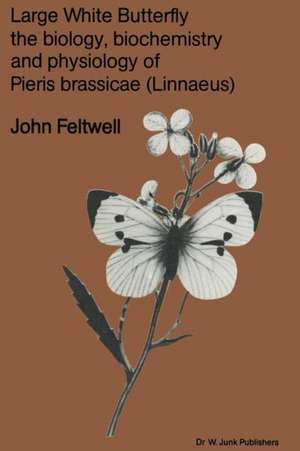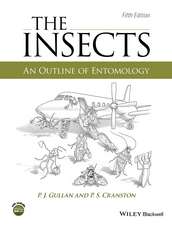Large White Butterfly: The Biology, Biochemistry and Physiology of Pieris Brassicae (Linnaeus): Series Entomologica, cartea 18
Autor J. Feltwellen Limba Engleză Paperback – 5 noi 2011
Din seria Series Entomologica
-
 Preț: 393.90 lei
Preț: 393.90 lei -
 Preț: 385.25 lei
Preț: 385.25 lei -
 Preț: 414.42 lei
Preț: 414.42 lei -
 Preț: 393.90 lei
Preț: 393.90 lei - 18%
 Preț: 830.70 lei
Preț: 830.70 lei - 18%
 Preț: 1220.75 lei
Preț: 1220.75 lei - 18%
 Preț: 1841.32 lei
Preț: 1841.32 lei - 18%
 Preț: 1218.04 lei
Preț: 1218.04 lei - 18%
 Preț: 1223.25 lei
Preț: 1223.25 lei -
 Preț: 385.62 lei
Preț: 385.62 lei - 24%
 Preț: 811.86 lei
Preț: 811.86 lei -
 Preț: 351.51 lei
Preț: 351.51 lei - 18%
 Preț: 810.99 lei
Preț: 810.99 lei - 18%
 Preț: 936.93 lei
Preț: 936.93 lei - 15%
 Preț: 642.83 lei
Preț: 642.83 lei -
 Preț: 393.59 lei
Preț: 393.59 lei - 18%
 Preț: 1664.26 lei
Preț: 1664.26 lei - 18%
 Preț: 1217.27 lei
Preț: 1217.27 lei - 18%
 Preț: 1386.30 lei
Preț: 1386.30 lei - 18%
 Preț: 1831.27 lei
Preț: 1831.27 lei - 18%
 Preț: 951.14 lei
Preț: 951.14 lei - 18%
 Preț: 2107.18 lei
Preț: 2107.18 lei - 18%
 Preț: 1219.77 lei
Preț: 1219.77 lei - 18%
 Preț: 1832.22 lei
Preț: 1832.22 lei - 18%
 Preț: 1229.91 lei
Preț: 1229.91 lei - 18%
 Preț: 1594.64 lei
Preț: 1594.64 lei - 18%
 Preț: 1833.16 lei
Preț: 1833.16 lei - 18%
 Preț: 1392.95 lei
Preț: 1392.95 lei - 18%
 Preț: 1237.93 lei
Preț: 1237.93 lei - 18%
 Preț: 1219.31 lei
Preț: 1219.31 lei - 24%
 Preț: 1073.70 lei
Preț: 1073.70 lei -
 Preț: 389.70 lei
Preț: 389.70 lei - 18%
 Preț: 1246.15 lei
Preț: 1246.15 lei - 18%
 Preț: 1226.70 lei
Preț: 1226.70 lei - 18%
 Preț: 1225.31 lei
Preț: 1225.31 lei - 18%
 Preț: 1232.89 lei
Preț: 1232.89 lei - 18%
 Preț: 1832.22 lei
Preț: 1832.22 lei - 18%
 Preț: 1232.71 lei
Preț: 1232.71 lei - 24%
 Preț: 1604.87 lei
Preț: 1604.87 lei
Preț: 403.53 lei
Nou
Puncte Express: 605
Preț estimativ în valută:
77.23€ • 79.94$ • 65.27£
77.23€ • 79.94$ • 65.27£
Carte tipărită la comandă
Livrare economică 05-19 martie
Preluare comenzi: 021 569.72.76
Specificații
ISBN-13: 9789400986404
ISBN-10: 9400986408
Pagini: 564
Ilustrații: 564 p.
Dimensiuni: 155 x 235 x 32 mm
Greutate: 0.78 kg
Ediția:1982
Editura: SPRINGER NETHERLANDS
Colecția Springer
Seria Series Entomologica
Locul publicării:Dordrecht, Netherlands
ISBN-10: 9400986408
Pagini: 564
Ilustrații: 564 p.
Dimensiuni: 155 x 235 x 32 mm
Greutate: 0.78 kg
Ediția:1982
Editura: SPRINGER NETHERLANDS
Colecția Springer
Seria Series Entomologica
Locul publicării:Dordrecht, Netherlands
Public țintă
ResearchCuprins
1. Nomenclature.- Section A. Classification of Pieris brassicae.- Section B. Infrasubspecific variation and nomenclature.- References cited.- Further references.- 2. Distribution.- - Introduction.- - World range (Europe, Middle East, North Africa, Indian subcontinent, U.S.S.R., Far East, Australia and New Zealand, South America).- References cited.- Further references.- 3. Life history.- - Original descriptions.- - Life cycle.- - Eclosion.- - Courtship.- - Copulation.- - Roosting site.- - Voltinism.- - Abundance.- - Natural checks of populations.- - Intraspecific relationships.- References cited.- Further references.- 4. Foodplants.- - Introduction.- - Principal foodplants.- - Unusual foodplants.- - Acceptability.- References cited.- Further references.- 5. Breeding.- - Introduction.- - Breeding.- - Synthetic diets.- - Current research on P. brassicae.- References cited.- 6. Development.- Section A. Imaginal discs.- Section B. Larval development.- References cited.- Further references.- 7. Morphology and Anatomy.- General introduction.- Section A. Morphology.- Section B. Anatomy.- References cited.- 8. Physiology.- - Colouration of the larva and pupa.- - Diapause.- - Excretion.- - Respiration.- References cited.- Further references.- 9. Hormones.- - Early work.- - Introduction.- - Sites of secretion.- References cited.- 10. Biochemistry.- - Introduction.- - Carbohydrates.- - Lipids.- - Proteins.- - Amino acids.- - Enzymes and coenzymes.- - Vitamins.- - Pigments.- - Nucleotides.- - Mustard oil glycosides.- - Biochemistry of silk.- - Biochemistry of pupal exuviae.- - Radionuclides used on P. brassicae.- - Inorganic ions.- - Sexual similarities and differences.- References cited.- Further references.- 11. Migration.- - Introduction.- - Examples of migration.- - Mark and recapture.- References cited.- Further references.- 12. Senses.- - Introduction.- - Visual senses.- - Olfactory senses.- - Tactile senses.- - Auditory sense.- - Barometric sense.- - Ultra-violet reflectance.- - Thermoregulation.- - Defense mechanisms.- - Chemoreception.- References cited.- Further references.- 13. Economic importance.- - Introduction.- - Depredations by country.- - Estimate of world damage caused by P. brassicae.- References cited.- Further references.- 14. Parasitic control.- Section A. General information.- Section B. Biology of some effective parasites.- References cited.- Further references.- 15. Pathogenic control.- General introduction.- Section A. Bacterial control.- Section B. Virus control.- Section C. Fungal control.- Section D. Protozoan control.- References cited.- Further references.- 16. Predators.- - Introduction.- - Bird predators.- - Hymenopterous predators and scavengers.- - Hemipterous predators.- - Coleopterous predators.- - Other insect predators.- - Vertebrate and other miscellaneous predators and scavengers.- References cited.- 17. Chemical control.- - Introduction.- Section A. Control pre-1945.- Section B. Control post-1945 in the field.- Section C. P. brassicae as laboratory insect for insecticide use.- Section D. Current chemical control of P. brassicae infestations.- References cited.- Further references.- 18. Integrated control.- References cited.- Botanical specific name index.- Zoological specific name index.











